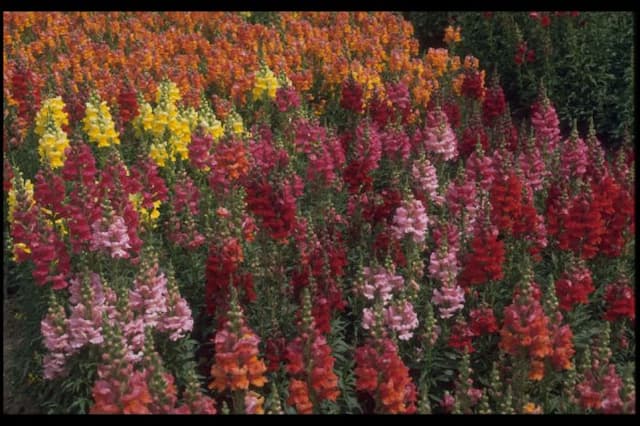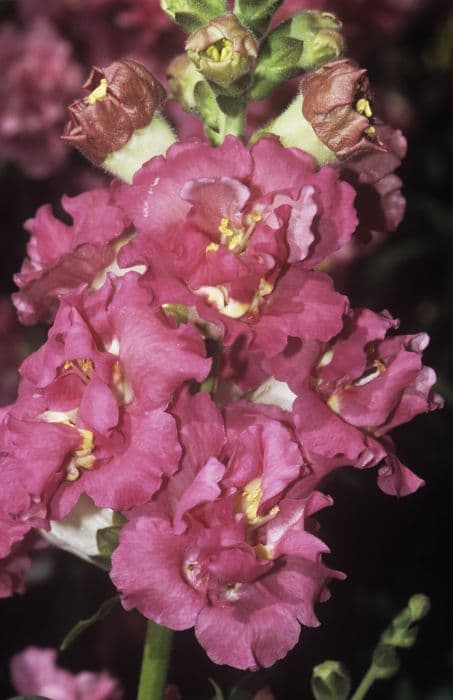Beardtongue Penstemon 'Elgar Firefly' (Elgar Series)

ABOUT
The Penstemon 'Elgar Firefly' from the Elgar Series is a striking perennial plant known for its vibrant and colorful appearance. The most captivating feature of this plant is its blossoms. The flowers are tubular in shape, resembling small trumpets clustered along the stem. They exhibit a brilliant color palette, which is a mix of fiery tones like reds and oranges, sometimes accompanied by hints of pink or purple, creating a glowing effect reminiscent of a firefly's light. The foliage of the Penstemon 'Elgar Firefly' provides an attractive backdrop to the vivid blooms. The leaves are typically lance-shaped and grow in a lush, verdant mound. Their deep green color contrasts nicely with the bright flowers, making the blooms stand out even more. The stems of the Penstemon 'Elgar Firefly' are sturdy and upright, which allows the plant to hold its blooms aloft, ensuring they are visible and can attract pollinators such as hummingbirds and bees. Overall, the plant presents a bushy and full appearance, with flowers generously covering the upper part of the plant, creating a dazzling display of color throughout its blooming season.
About this plant
 Names
NamesFamily
Plantaginaceae
Synonyms
Beardtongue, Firefly Penstemon
Common names
Penstemon 'Elgar Firefly'
 Toxicity
ToxicityTo humans
Penstemon, including the variety 'Elgar Firefly', is generally considered non-toxic to humans. There is no widespread evidence to suggest that Penstemon poses significant health risks when touched or ingested. However, as with any plant, individuals may have varying sensitivities, and it's always prudent to avoid ingesting plants not meant for consumption as they could potentially cause mild stomach upset or an allergic reaction in sensitive individuals.
To pets
Penstemon, including the 'Elgar Firefly', is not known to be toxic to pets such as dogs and cats. These plants are typically safe around animals, and there have been no widespread reports of serious illness as a result of pets ingesting Penstemon. However, individual pets may have different reactions or sensitivities, and ingestion of plant material can sometimes lead to gastrointestinal upset or an allergic reaction in some animals. It's always a good practice to discourage pets from eating ornamental plants to avoid any potential issues.
 Characteristics
CharacteristicsLife cycle
Perennials
Foliage type
Semi-deciduous
Color of leaves
Green
Flower color
Red
Height
2 feet [60 cm]
Spread
2 feet [60 cm]
Plant type
Herb
Hardiness zones
8
Native area
North America
Benefits
 General Benefits
General Benefits- Aesthetic Appeal: Adds vibrant color with its fiery red flowers, enhancing the visual interest of gardens and landscapes.
- Attracts Pollinators: Flowers of the plant attract bees, butterflies, and hummingbirds, supporting local ecosystems.
- Drought Tolerance: Once established, Penstemon 'Elgar Firefly' is quite drought-resistant, meaning it requires less water, making it suitable for xeriscaping.
- Low Maintenance: Requires minimal care once established, which is great for gardeners looking for plants that do not need a lot of attention.
- Cold Hardy: It can tolerate cold temperatures, making it suitable for planting in a variety of climates.
- Long Blooming Season: It has a lengthy flowering period which ensures a lasting display of color in the garden.
- Versatility: Suitable for planting in borders, rock gardens, and containers, offering multiple landscaping options.
 Medical Properties
Medical PropertiesThis plant is not used for medical purposes.
 Air-purifying Qualities
Air-purifying QualitiesThis plant is not specifically known for air purifying qualities.
 Other Uses
Other Uses- Artistic inspiration: The vibrant colors of Penstemon can serve as a muse for artists and designers looking for unique color palettes and organic forms in their work.
- Educational tool: Botanical gardens and schools can use the plant to teach about pollination and the importance of attracting bees and other pollinators in the garden.
- Photography subject: Due to their striking appearance, Penstemon can provide an excellent subject for photographers practicing macro and nature photography.
- Garden competitions: Penstemon 'Elgar Firefly' can be entered into garden and flower show competitions for their aesthetic qualities and unique characteristics.
- Tattoo design: The unique form and colors of Penstemon flowers are sometimes used as inspiration for botanical-themed tattoos.
- Fabric prints: The distinct look of Penstemon flowers can be used as a motif in textile designs, especially for summer fashion collections.
- Theme gardens: Penstemon can be used in themed garden designs, such as 'fire' gardens with a selection of red, orange, and yellow flowering plants.
- Culinary decoration: Although not edible, Penstemon flowers can be used as an ornamental, non-toxic garnish for plates in upscale or artisan culinary presentations.
- Environmental studies: The plant can be used as an indicator species in research studies looking at the health of ecosystems and the impact of climate change on flowering times.
- Crafting: Dried Penstemon flowers can be incorporated into crafts such as wreaths or potpourri, adding both color and a natural element to handmade items.
Interesting Facts
 Feng Shui
Feng ShuiThe Penstemon is not used in Feng Shui practice.
 Zodiac Sign Compitability
Zodiac Sign CompitabilityThe Penstemon is not used in astrology practice.
 Plant Symbolism
Plant Symbolism- Attraction: Often the vibrant colors of Penstemon plants, including the 'Elgar Firefly', attract pollinators, symbolizing allure and magnetism in human relationships.
- Endurance: Penstemons are hardy and can survive in rough conditions, representing the ability to endure and persist through challenges.
- Diversity: With the vast variety within the Penstemon genus, this plant symbolizes the beauty of diversity and variety in life.
- Boldness: 'Elgar Firefly', with its bright hues, stands out boldly in gardens, symbolizing courage and the willingness to stand out.
- Health: Penstemons are often associated with good health and vitality, owing to their use in native medicine and their robust nature.
 Water
WaterBeardtongue should be watered deeply, allowing the soil to dry out slightly between waterings. This typically means providing about 1 inch of water per week, whether from rainfall or irrigation. During hot, dry spells, you might need to water twice a week to maintain moisture without overwatering. If grown in containers, check the moisture level more frequently and water when the top inch of soil feels dry to the touch. It's better to avoid frequent, shallow watering which can encourage weak root systems and stress the plants during dry periods. Always water the base of the plant to keep the foliage dry and minimize disease risk.
 Light
LightBeardtongue thrives in full sun, meaning it requires at least 6 to 8 hours of direct sunlight each day. The ideal spot for this plant is in an area that receives ample morning sunlight and some protection from the intense afternoon sun in hotter climates. Although it can tolerate partial shade, too little light can lead to leggy plants and reduced flowering.
 Temperature
TemperatureBeardtongue is hardy and can endure temperatures as low as 10 to 20 degrees Fahrenheit but for optimal growth, maintain a temperature between 60 to 75 degrees Fahrenheit. It can tolerate high temperatures well, but if the temperature consistently exceeds 85 to 90 degrees Fahrenheit, provide some afternoon shade to prevent stress.
 Pruning
PruningPrune beardtongue to remove spent flower spikes and promote a second bloom; this can also help maintain the plant's shape and vitality. It's best to prune in late winter or early spring before new growth starts. Pruning can be done again after the first flush of flowers fades in the summer, to encourage a second flowering period.
 Cleaning
CleaningAs needed
 Soil
SoilBeardtongue, commonly known as Penstemon, thrives best in well-draining soil with a slightly acidic to neutral pH of about 6.0 to 7.0. A mix containing loam, sand, and a bit of compost or organic matter will create an ideal environment. Good drainage is critical to prevent root rot and promote healthy growth.
 Repotting
RepottingBeardtongue plants typically do not require frequent repotting and can often remain in the same pot for several years. Overcrowded plants can be divided and repotted in the spring to encourage healthy growth and blooming.
 Humidity & Misting
Humidity & MistingBeardtongue plants prefer moderate humidity levels but are quite adaptable and can tolerate the drier conditions often found in a typical home or garden environment without requiring special humidity considerations.
 Suitable locations
Suitable locationsIndoor
Use bright light, well-draining soil, and keep moderately dry.
Outdoor
Plant in sun, in well-draining soil, and space 12 inches apart.
Hardiness zone
4-9 USDA
 Life cycle
Life cycleThe life of the Penstemon 'Elgar Firefly' typically begins with seed germination, which occurs when conditions of warmth and moisture are optimal, usually in the spring. Following germination, the seedlings develop into juvenile plants, establishing a root system and producing a rosette of foliage. As the plants mature, they enter the vegetative stage, during which they grow stems and more leaves to maximize photosynthesis and gather energy. This species then moves into the flowering stage, generally in late spring to early summer, in which it produces vibrant tubular flowers that attract pollinators. After pollination, the plant creates seed pods that mature, eventually releasing seeds to complete the reproductive cycle. In the final stage of its life cycle, the plant may die back, especially in colder climates, but can also survive as a perennial, regrowing from the base the following season.
 Propogation
PropogationPropogation time
Spring to Summer
The Penstemon 'Elgar Firefly', also known as Beardtongue, can be propagated primarily through stem cuttings. This method is often considered the most popular because it is relatively easy and tends to yield good results. To propagate by cuttings, one should take a healthy piece of stem approximately 4 to 6 inches (10 to 15 centimeters) long. This is best done in late spring or early summer when the plant's growth is most vigorous. The cut stem should have several leaves removed from the lower half and the cut end should be dipped in rooting hormone before being placed into a well-draining potting mix. The cutting should then be kept in bright, indirect light and maintained in a humid environment until roots have developed, which can usually be observed within a few weeks.





![Snapdragon [Pretty in Pink]](/_next/image?url=https%3A%2F%2Fplants-admin.emdemapps.com%2Fimages%2Fplants%2F%2Fimages%2F604b5cb3b5385.png&w=640&q=75)



